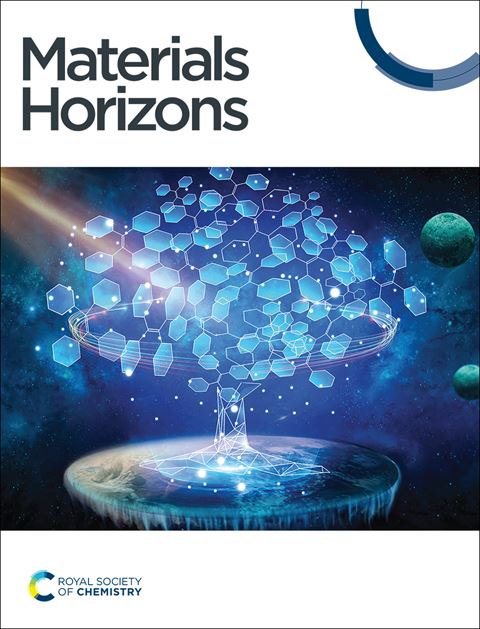垂直堆叠石墨烯/h-BN异质结构的界面工程作为过氧化氢合成的有效电催化剂。
IF 12.2
2区 材料科学
Q1 CHEMISTRY, MULTIDISCIPLINARY
引用次数: 0
摘要
最近,据报道,平面内石墨烯(G)/六方氮化硼(h-BN)(G/h-BN)异质结构通过2-氧还原反应(ORR)为H2O2的合成提供了催化活性。然而,关于垂直堆叠的G/h-BN异质结构的报道很少,该异质结构指的是石墨烯畴在h-BN表面的堆叠。本文提出了一种模拟化学气相沉积方法,通过在多孔h-BN片上原位生长石墨烯量子点(GQDs)来制备丰富的垂直堆叠G/h-BN异质结构。在碱性环境下,我们的垂直堆叠异质结构催化剂的性能优于已报道的碳基电催化剂,在宽电位范围内(0.35 V-0.7 V vs.RHE),H2O2选择性为90-99%,法拉第效率超过90%,1167 mmol GC催化剂-1 h-1的高质量活性。实验结果和密度泛函理论(DFT)模拟验证了垂直堆叠异质结构对2e-ORR表现出优异的催化性能,并且B中心AB堆叠模型中的边缘B原子是最具活性的催化位点。这项研究充分证明了垂直堆叠的G/h-BN异质结构具有良好的催化活性,并为制造其他垂直堆叠的异质结构提供了一条简单的途径。本文章由计算机程序翻译,如有差异,请以英文原文为准。
Interfacial engineering of a vertically stacked graphene/h-BN heterostructure as an efficient electrocatalyst for hydrogen peroxide synthesis.
Recently, it was reported that an in-plane graphene (G)/hexagonal boron nitride (h-BN) (G/h-BN) heterostructure provided the catalytic activity for H2O2 synthesis by the 2 e- oxygen reduction reaction (ORR). However, there are few reports on the vertically stacked G/h-BN heterostructure, which refers to the stacking of graphene domains on the surface of h-BN. Herein, a simulated chemical vapor deposition method is proposed for fabricating a heterostructure of abundant vertically stacked G/h-BN by in situ growing graphene quantum dots (GQDs) on porous h-BN sheets. The performance of our vertically stacked heterostructure catalyst is superior to that of reported carbon-based electrocatalysts under an alkaline environment, with an H2O2 selectivity of 90-99% in a wide potential range (0.35 V-0.7 V vs. RHE), over 90% faradaic efficiency, and high mass activity of 1167 mmol gcatalyst-1 h-1. The experimental results and density functional theory (DFT) simulation verified that the vertically stacked heterostructure exhibits an excellent catalytic performance for the 2 e- ORR, and the edge B atoms in the B-centered AB stacking model are the most active catalytic sites. This research adequately demonstrates the promising catalytic activity of the vertically stacked G/h-BN heterostructure and provides a facile route for fabricating other vertically stacked heterostructures.
求助全文
通过发布文献求助,成功后即可免费获取论文全文。
去求助
来源期刊

Materials Horizons
CHEMISTRY, MULTIDISCIPLINARY-MATERIALS SCIENCE, MULTIDISCIPLINARY
CiteScore
18.90
自引率
2.30%
发文量
306
审稿时长
1.3 months
期刊介绍:
Materials Horizons is a leading journal in materials science that focuses on publishing exceptionally high-quality and innovative research. The journal prioritizes original research that introduces new concepts or ways of thinking, rather than solely reporting technological advancements. However, groundbreaking articles featuring record-breaking material performance may also be published. To be considered for publication, the work must be of significant interest to our community-spanning readership. Starting from 2021, all articles published in Materials Horizons will be indexed in MEDLINE©. The journal publishes various types of articles, including Communications, Reviews, Opinion pieces, Focus articles, and Comments. It serves as a core journal for researchers from academia, government, and industry across all areas of materials research. Materials Horizons is a Transformative Journal and compliant with Plan S. It has an impact factor of 13.3 and is indexed in MEDLINE.
 求助内容:
求助内容: 应助结果提醒方式:
应助结果提醒方式:


